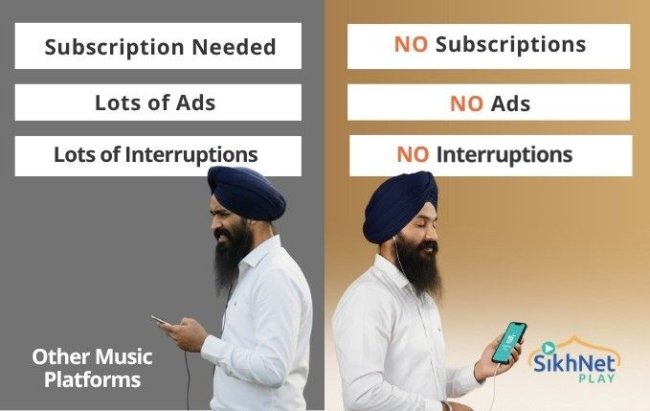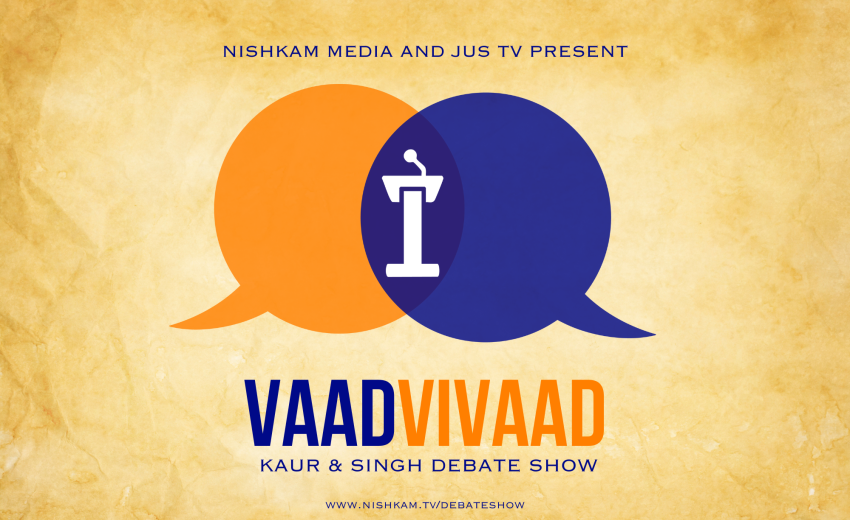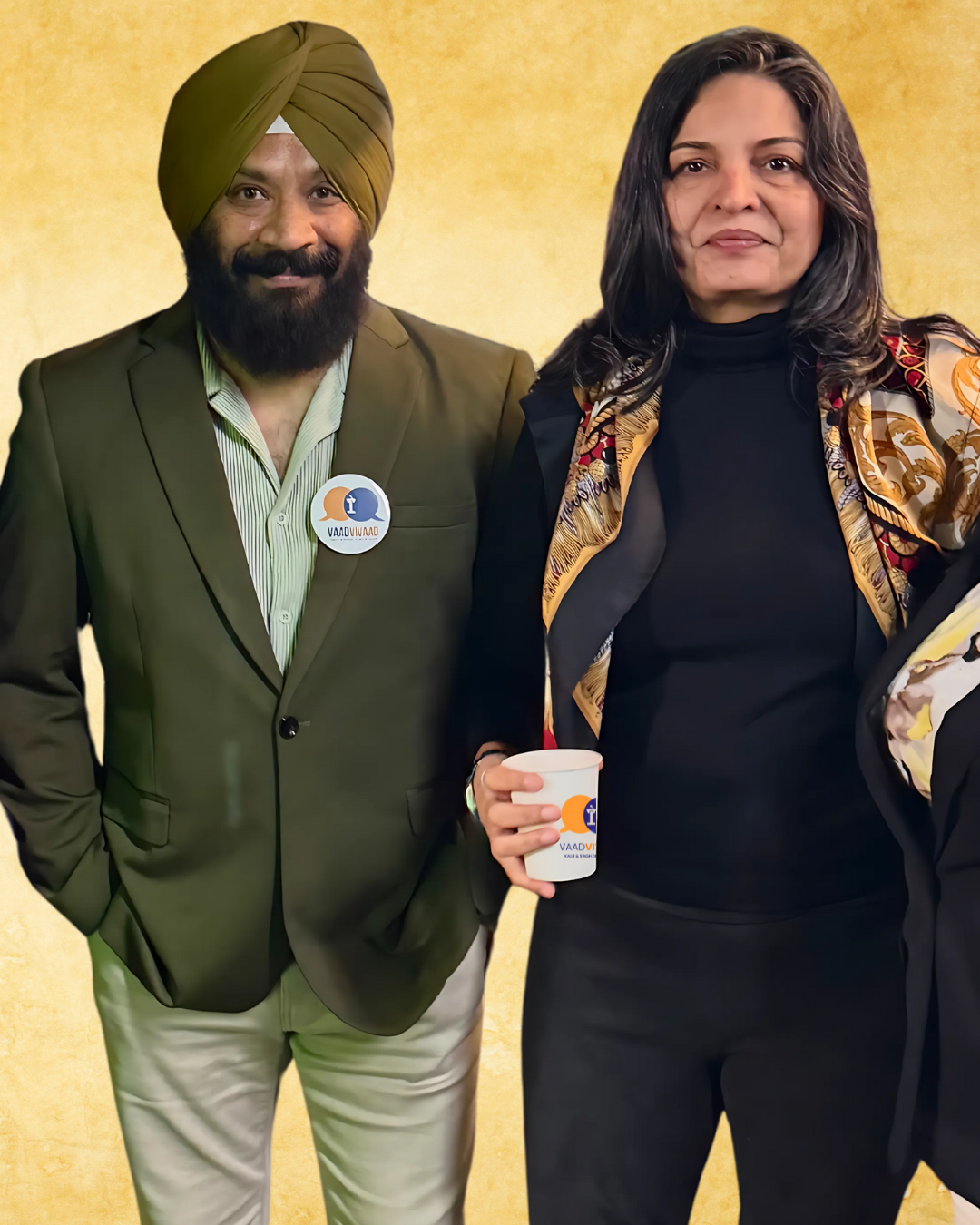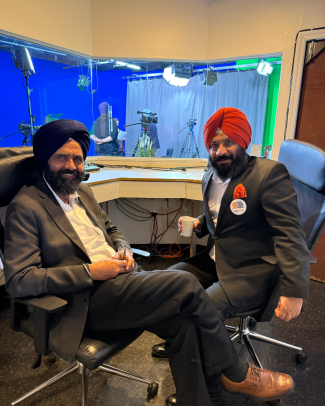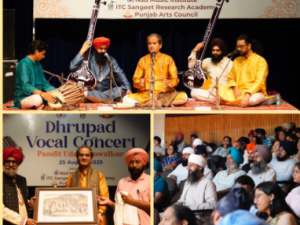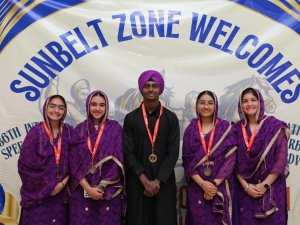The very first Kaur and Singh Sikh Youth Debate Show airs on Jus TV, featuring eight Sikh high school students debating controversial topics in Sikhi. Following the principles and ideologies of the Gurus, each student debates the pros and cons of every subject from both sides of the issue using the Lincoln-Douglas debate format to examine resolutions from every angle. Historic evidence sourced from Sikh ideology, including quotes from the Guru Granth Sahib, is used to arrive at the truth. Students compete in rounds with winners picked by a team of Sikh judges who are experts in debate.
The Sikh Tradition of Debate in the Pursuit of Truth Originated with the First Guru, Nanak Dev
Guru Nanak Dev Ji traveled the known world for 25 years. Wherever he went, he entered discussions and engaged in debates as a platform for teaching and propagating the fundamental values of Sikhi. Using dialogue, deliberation, contemplation, and reflection as tools to expose fallacies, the Guru’s discourse deeply questioned long-held philosophies. He encouraged critical thinking as a means of discovering and uncovering the truth. His challenging encounter, “Sidh Gosht ~ Conversations with the Siddhas”, is a fearless exchange of ideas, recorded in Sri Guru Granth Sahib on Ang 938.
Sikh Gurus Used Debate to Propagate Sikh Ideas and Ideals:
Guru Nanak Dev Ji emphasized that the pursuit of truth, contentment, and reflective discussion leads to the fulfillment of life’s purpose. The Gurus held court in a manner that valued dialogue, questions, and critical thinking. Guru Gobind Singh had 52 or more court scholars who deliberated and wrote on various topics.
“The Sikh Gurus engaged in debate with scholars of their time, not to win arguments, but to seek the truth”. – Harbaldeep Singh Show Director and Coordinator
VAAD VIVAAD Five Fundamental Core Values inspired by Guru Nanak:
ਸਤਿ Sat Truth
ਨਿਮਰਤਾ Nimrata Humility
ਜੁਗਤੀ Jugti Technique
ਸੇਵਾ Seva Service
ਗਿਆਨੁ ਧਿਆਨੁ Gian Dhian Knowledge and Wisdom (contemplation of knowledge)
VAAD VIVAAD Premise Based on Gurbani Tuks:
ਵਿਦਿਆ ਵੀਚਾਰੀ ਤਾਂ ਪਰਉਪਕਾਰੀ ॥
Vidya veecharee taan parupkaree
Contemplate and reflect upon knowledge, and you will become a benefactor to others. SGGS Ang 356
ਥਾਲ ਵਿਚਿ ਤਿੰਨਿ ਵਸਤੂ ਪਈਓ ਸਤੁ ਸੰਤੋਖੁ ਵੀਚਾਰੋ ॥
Thal vich tin vastoo paeeo sat santokh veechaaro
Upon this Plate, three things have been placed: Truth, Contentment, and Contemplation.
ਅੰਮ੍ਰਿਤ ਨਾਮੁ ਠਾਕੁਰ ਕਾ ਪਇਓ ਜਿਸ ਕਾ ਸਭਸੁ ਅਧਾਰੋ ॥
Amrit naam thaakar kaa paio jis kaa sabhas apaaro
The Ambrosial Nectar of the Naam, the Name of our Lord and Master, has been placed upon it as well; it is the Support of all. SGGS Ang 1429
Season 1 Episode 1 Curtain Raiser
Introducing Organizers of the Debate Project and Participants
Season 1 Episode 1 introduces the organizers, student debaters, and judges. The participants discuss their concept of reflective debate throughout Sikh history and its relationship to the philosophies of the Lincoln-Douglas debate format.
Niskhkam TV provided debate training to the youth. Jus TV provided the platform, production expertise, and a belief that the show would be of interest to a much larger audience. With the vision of Penny Sandhu, CEO of Jus TV, the VAADVIVAAD show became a reality, amplifying Sikh voices to reach mainstream media. Jus TV’s global presence broadcasts the show so that it can be observed by a worldwide audience rather than just the Sikh community.
Meet the Show Creators:
- Show Host, Aashmeeta Sandhu, Show Host with Jus Punjabi Studios in New York City – “At VAAD VIVAAD we believe transparency builds trust, mentorship, and leadership.”
- Show Creator, Davinder Singh Garcha – “We want to teach our kids about Sikh history and then bring up the Hot Button issues and let them figure out that there are multiple viewpoints and sometimes all are valid.”
- Harbaldeep Singh, Show Director and Coordinator – “This is not just a debate show, it’s about preparing young Sikhs to think critically, speak with conviction, and stand for their values.”
The coaches trained students in debate and also organized a team of judges who had real debate experience, whose main motive is seva (service), to empower Sikh youth. The show takes viewers behind the scenes to watch the judges deliberate and pick the winners.
- Azman Singh, Debate Coach and Show Runner, helped to create the curriculum. – “Learning the process of structured debate can help you integrate your Sikh knowledge with general intellectual growth as you grow older.”
- Divjot Singh, Debate Coach and Show Runner – “Changing the narrative around debate, it should not be this emotional, theatrical fight, instead, it should be an [objective] exchange of ideas and learning from one another.” – Divjot Singh, Debate Coach and Show Runner
Judges Perspectives:
Six judges have been selected to judge the winners of the debates:
- Amber Garcha: “Structured debate forces you to take time to think, look at real evidence, rather than just your personal biases or experiences”.
- Tejpaul Singh: “The Lincoln-Douglas debate format is unique because a contestant has to argue for both the affirmative and the negative and look at the core resolution.”
- Tarina Ahuja: “Structured debate for Sikh youth cannot be overstated. Our faith teaches us that courage to speak up, not just on behalf of yourself, but on behalf of others, is one of the most important things we can do.”
- Arjun Grover: “Structured debates are quite important for Sikh leadership because they provide two sides of the story, and eliminate bias.”
- Goonmeet Kaur: “The Lincoln-Douglas debate format is unique because a contestant has to argue for both the affirmative and negative side, put personal beliefs aside, and look at the core resolution.”
- Naunihal Virk: “It empowers you to see both sides of an issue. When forced to argue the pro side and later argue the negative side. it makes is a less personal argument, and more of a discussion to see both sides of an issue.”
Three components of debate that judges consider are:
- Assertion: stating your claim and position that can be backed by evidence.
- Reason: logical reasons for your point of view and why you believe it to be true.
- Evidence: Information that supports your assertion and reason, such as facts, statistics, examples, expert opinion, etc.
Structured debate value framework includes:
- Opening statement, presentation of the main argument, with supporting evidence.
- Rebuttal, a response refuting the opposition.
- Closing statement, to summarize and reiterate main points.
When using Guru Granth Sahib to justify a position, a specific quote tailored to the particular situation is stronger evidence than a general quote that could apply to various situations.
When judging, the challenge is to carefully deliberate, meticulously weighing every argument and response to determine which arguments and evidence carry the most weight. Ultimately, the decision can rest on the strength of the value framework and the skill to communicate key issues, persuade, and empathize with both sides of an argument.
Meet the Eight Contestant Finalists:
Each student introduces themselves and shares their perspective:
- Amreen Gurm grade 9 NJ – ‘Public speaking is an important skill that everyone should learn.’
- Bakshish Jimenez grade 10 MA – ‘This program has made me more confident when speaking.’
- Jasjot Padam grade 9 – ‘Performing on National TV is a super cool opportunity.’
- Mehar Dhall grade 9 MA – ‘I have confidence that my opinion matters.’
- Pavit Singh grade 11 VA – ‘It's possible to be influenced and have many different perspectives.’
- Ruhani Singh grade 12 NC – ‘I like how Sikh values of humility come into discourse and debate.’
- Samir Kirkewal grade 10 MA – ‘Speaking spontaneously on the spot has improved my skill.’
- Sumair Singh grade 10 MA – ‘I learned to comprehend and articulate my thoughts better.’
Parental viewpoints: Parents shared gems like these.
- “Work together using various aspects of logical thinking and problem-solving to arrive at a resolution.”
- “Cultivate a path to do something bigger than yourself and contribute to a cause that is bigger than yourself.”
Guests of Honor Viewpoints:
- Dr. Gunisha Kaur, Associate Professor at Weill Cornell Medicine NYC, Director of Human Rights Impact Lab, and Co-medical Director of the Center for Human Rights – “To consider both sides of an argument and convey it back is what makes change… takes good ideas…and converts them into action, is how debate furthers humanitarian causes.”
- Simran Jeet Singh, Professor of Religion at Union Theological Seminary – “One of my books, “The Light We Give, How Sikh Wisdom Can Transform Your Life,” has elements of Sikh teachings and philosophy that fit nicely with the practice of debate, one of which is introspection.”
Meet the Sponsors:
- The Sikh Coalition Representative Executive Harman Singh – “We are proud to support the Kaur and Singh VAAD VIVAAD Debate Show. We believe in empowering our youth, and this show encourages our youth to lead with clarity and Sikh values. We are proud to be a part of this television program. Waheguru ji ka Khalsa Waheguru ji ki Fateh.”
- Upkarn Bhogal – “Sat Siri Akal. I’m honored to sponsor the Kaur and Singh VAAD VIVAAD Debate show. I believe in the power of young minds and the importance of providing our Sikh youth with platforms to learn, express, and lead. Join me in backing this incredible initiative, because when our kids thrive, our community thrives.”
Season 1 Episode 2 Quarter Final Debate Amreen Kaur vs Pavit Singh
Introducing the Contestants, Let the Debates Begin
Season 1 Episode 2 Kaur vs Singh: Contestant Amreen Kaur, a freshman from New Jersey, faces off with Contestant Pavit Singh, a junior from Virginia. What are these two contestants feeling as they go on stage? What are the rules of this debate? Who are the judges? Which one of these dynamic speakers, Kaur or Singh, will win this thought-provoking argument about the purpose of the Gurdwara and what functions should be allowed to take place? Is a gurdwara simply for worship, or should it be a community meeting place?
The Stage Setting:
What appears to be a virtual semi-circular stage features two wooden podiums and two debaters, with the show host at the center. The carpeting and wall panels are royal blue, interspersed with wood panels. A band of white with blue stars circles the stage just below the ceiling. The Nishkam.tv and Jus TV logos appear at the center. Just below is the large circular white, orange, and blue, VAAD VIVAAD logo. On either side of the stage is a wood-paneled wall hung with mottos printed with blue Gurmukhi fonts on a cream background.
To the left of the stage is hung the motto of the premise upon which VAAD VIVAAD is founded:
ਵਿਦਿਆ ਵੀਚਾਰੀ ਤਾਂ ਪਰਉਪਕਾਰੀ
CONTEMPLATE AND REFLECT ON KNOWLEDGE,
AND YOU WILL BECOME A BENEFACTOR TO OTHERS.
To the right of the stage is hung the motto of VAAD VIVAAD's core values:
ਸਤਿ
Truth
ਨਿਮਰਤਾ
Humility
ਜੁਗਤੀ
Technique
ਸੇਵਾ
Service
ਗਿਆਨੁ ਧਿਆਨੁ
Knowledge and Wisdom
Let the Show Begin
The show starts with Ardas recited by a young student.
“We begin with Ardas to remind us why we are here, not just to win debates, but to grow with grace and goodwill.” – Aashmeeta Sandhu, Show Host
Of the original 14 debaters, eight finalists have been selected and paired into four groups of two students, with one arguing in favor and the other against the resolution. In the 2nd round, the debaters switch sides. The student who formerly argued in favor will argue against, and vice versa. The student who formerly argued against will argue in favor of the resolution.
“Why? Because true leadership requires mental flexibility, the ability to understand, represent, and challenge both sides of an issue… That’s the heart of VAAD, developing the ability to see both sides.” – Aashmeeta Sandhu, Show Host
Students do not pick their opponents. A random pair generator is used to match students in the debate.
The students continue arguing in pairs until only two students remain in the grand finale championship round.
“One debate, one champion, a milestone moment in Sikh youth history.” – Aashmeeta Sandhu, Show Host
The first debate of the first-ever televised Sikh youth debate show features quarter-final debates.
Resolved: A Gurdwara is a Place of Worship for Sikhs.
Each student brings their personal voice, research, and experience. They may draw on Sikh history or modern interpretations.
“With eight individual perspectives on a single resolution, this is where critical thinking meets Gurmat values, where respectful disagreement becomes a learning too.” – Aashmeeta Sandhu
Debate Structure:
Debates follow a formal Lincoln-Douglas format with a total of 32 minutes. This includes 20 minutes of structured debate time and 12 minutes of prep time.
- The debaters shake hands, return to their podiums, and commence arguments.
- The PRO debater begins with a 4-minute presentation of their argument.
- The NEG debater presents a rebuttal with 7 minutes of counterarguments.
- The PRO debater counters with a 3-minute rebuttal followed by a 3-minute crystallization closing speech.
- The NEG debater counters with a 3-minute closing speech.
Prep time can be used before or between rounds.
Choosing a Winner:
Audience participation relies on viewers to phone in and select a favorite.
Criteria for Judging the Lincoln-Douglas Format of Debate
The final winner is determined by a team of three judges, Tejpaul Singh, Amber Garcha, and Naunihal Virk, who base their criteria for picking a winner on the Lincoln-Douglas format for debate:
- “Value framework” is the moral principle, or standard, that contestants use as the basis on which to frame and rest the argument. Debaters defend and apply this framework with their intentions, evidence, and justification.
- “Clash” is how well debaters engage their opponents' arguments. Contention level of specific points, evidence, agreement, and validation of an opponent’s point of view while stating a stronger, more significant, or compelling case.
- “Quality of evidence” is how well research has been done. Are the sources sound? Have connections been made between points? Have logical fallacies been avoided?
- “Speaker points” are used to break a tie. The speakers will be assigned a value from 0 to 10. Confidence, clarity, concise delivery, tone, inflection, and eye contact all count.
The “Decision Certificate” will determine the winner of the debate. Judges evaluate “flow” of contention and rebuttal, “valid criterion”, fill out with “pro” and “neg,” and mark down the speaker's points they have agreed on.
You will need to tune in and watch every episode to find who wins each debate. I promise it will be thought-provoking. After watching Round 1, I found myself remembering personal experiences and thinking of examples that could influence both sides of the debate that had not yet been expressed. I’m curious how this will play out. Who will be the final winner? Episode 1 has strong contenders. How will their arguments change when debating the other side of the issue? Will they make it through to the end? Stay tuned!
SikhNet Conversation with Show Creators Harbaldeep Singh and Davinder Singh Gorcha
Sikhnet posed questions that were thoughtfully answered with a collaborative effort between Harbaldeep Singh and Davinder Singh, which appear in “italics and quotes” below.
SikhNet: I found the show very compelling for numerous reasons. I love how putting the program together involves family, community, as well as Sikhi. The practical aspect of being able to discuss a controversial subject without having a heated argument is certainly justification enough for engaging in debate. Watching the show gave me insights into gurdwara debates, political debates, and courtroom debates. What aspects of life and future direction can benefit youth trained in debate?
“While we all are expected to draw the Sikhi way of learning and living from Guru Granth Sahib only, there are many aspects of daily life that are expected to be led by the Sangat and the representatives. Guru Gobind singh essentially established a democratic way in 1699 by diverting his powers to “Panj Piaras” and “Sangat.” Like any democracy, this has lead to some difference in opinions on various topics among Sikhs such as vegetarian diet, following various rituals, ways of worship, and Dasam Granth reading, etc. We want to teach Sikh youth that sometimes there is no absolute answer for any issue/problems and it is OK to have differences in opinions and we should all learn to see both sides of a debate.”
SikhNet: I watched a female 9th grader go up against a male 11th grader. Does gender, age, and experience contribute to the ability to win a debate?
“Regarding gender, we take inspiration from Guru Gobind Singh - when he established Khalsa in 1699, he treated all genders equally and even the dress code is same for everyone. We follow the same principle in this debate show - all genders (even outside of traditional ones) will be treated equally and will be paired using random number generators.
Regarding age, we are targeting the debate show for high school level youth. So all the topics are chosen based on when an average 9th graders can understand them fully and debate on them. So there is no specific advantage to the age, as you will see in the debate rounds.
Regarding experience, it may sometimes help if one is coming from a family who is more connected with Sikhi and if one has participated in similar debates our speeches previously. But that advantage vanishes very soon as the other kids also learn from coaching and by participating in the debates.”
SikhNet: The topic debated regarding the gurdwara affects every Sikh, as I'm certain every topic debated will. I can think of so many debate-worthy historical controversies. How did you narrow down the possibilities to decide on topics?
“First of all, the main purpose of Vaad-Vivaad debate show is NOT to provide any definitive answer or take a specific side on any issue we discuss. Instead, the main purpose is to teach Sikh youth how to debate in a democratic and Sikhi way, without yelling or using abusive language, regardless of which side of the issue you take.
The debates topics are chosen very carefully with discussion with Sikh scholars and using the following high-level criteria:
- The topic is of current interest to the community, especially the youth.
- The topic is related broadly to Sikhi (e.g., Gurbani, gurdwaras, sangat, politics, etc.)
- The topic is not extremely controversial or adverse to any government, religion or other major organization.
- The topic has evenly divided opinions and arguments on both sides to avoid any clear winners or losers.
- The topic is framed in a language that is broad enough to encourage open ended arguments where each student can form a unique argument based on their learnings and knowledge.
Also, our secondary purpose is not to test the knowledge of students but instead foster an environment of learning and researching. For the first season, multiple debate topics wrestled chosen and provided to all students few weeks ahead of the program so they can prepare well for each topic. We selected three topics for the first season:
- Quarter-Finals Topic: Gurdwara is a place of worship for Sikhs
- Semi-Finals Topic: All Gurdwaras in the USA should impose a ban on speeches from politicians
- Finals Topic: Sikhs should carry modern weapons in contemporary times
Finally, we would welcome any suggestion on the topics that impact the Sikh community but we will use the above criteria before making it available for the program.”
SikhNet: How does one access Jus TV to watch VAAD-VIVAAD?
“Jus Punjabi is available on multiple platforms, including DISH, SLING, CHARTER, FiOS, Verizon in the US, JIO in India, and IPTV worldwide”.
SikhNet: The show was filmed in NYC. Is it broadcast from the USA, Punjab, or another country?
“The show was filmed at Jus Punjabi Studios in New York and is broadcast from the USA. It airs every Sunday from 7:00–8:00 PM EST and PST and it repeats in the week. Currently, the show is available in the United States, Canada, India, the United Arab Emirates, New Zealand, and Australia, with 10 million Jus TV viewership. Here are timings graphics”:
SikhNet: Will all episodes be available on YouTube, and are there plans for a second season?
“There are 16 episodes in Season 1, including:
- 1 Curtain Raiser
- 8 Quarter-Final debates
- 6 Semi-Finals
- 1 Grand Finale
We are releasing all episodes on the Nishkam TV YouTube Channel after their television premiere. You can view the full playlist here”:
https://www.youtube.com/playlist?list=PL-LDdxZs5ZBsug_TDizAXBw7R8CbLQzfQ
“For the Grand Finale, our Guest of Honor was Dr. Gunisha Kaur, a leading voice on refugee health and human rights. Her presence aligned perfectly with our Season 1 theme: “Kaurs Who Inspire.”
As for Season 2—yes, plans are already underway, and we are exploring ways to expand the format to include even more participation from Sikh youth globally.
This program is the first-ever televised Sikh debate show of its kind, designed to foster respectful discourse, critical thinking, and a deeper connection to Sikhism among young people. It brings together families, Gurdwaras, mentors, and professionals to uplift the next generation of Sikh thinkers and leaders collectively.
We hope to encourage readers to consider supporting or inquiring about future participation, partnership, or broadcast opportunities. Inquiries are welcome at”:
